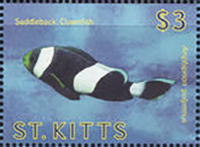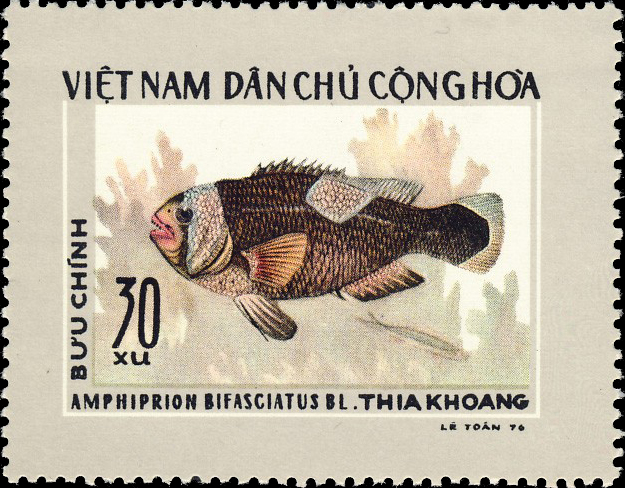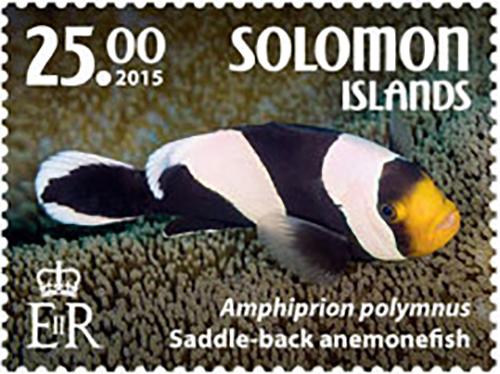Amphiprion polymnus Linnaeus, 1758

Phylum: Chordata Haeckel, 1874
Subphylum: Vertebrata Lamarck J-B., 1801
Classe: Actinopterygii Klein, 1885
Ordine: Perciformes Bleeker, 1859
Famiglia: Pomacentridae Bonaparte, 1832
Genere: Amphiprion Bloch and Schneider, 1801
English: Brownsaddle clownfish, Saddleback clownfish, Yellowfinned anemonefish
Descrizione
La livrea può variare dalla regione in cui vive. In alcune aree è totalmente nero con due bande bianche molto marcate, in altre, la sua colorazione scura tende dal marrone al giallo arancio e può avere una terza banda bianca. Può raggiungere la lunghezza massima di 12 cm.
Diffusione
Si può trovare in simbiosi con Stichodactyla haddoni nelle barriere coralline dell'oceano Pacifico occidentale.
Sinonimi
= Amphiprion bifasciatus ssp. annamensis Chevey, 1932 = Amphiprion intermedius Schlegel and Müller, 1839 = Amphiprion laticlavius Cuvier in Cuvier and Valenciennes, 1830 = Amphiprion trifasciatus Cuvier in Cuvier and Valenciennes, 1830 = Anthias bifasciatus Bloch, 1792 = Coracinus vittatus Gronow in Gray, 1854 = Lutjanus jourdin Lacépède, 1802 = Paramphiprion hainanensis Wang, 1941 = Perca polymna Linnaeus, 1758.
Bibliografia
–Jenkins, A.; Allen, G.; Myers, R.; Yeeting, B. & Carpenter, K.E. (2017). "Amphiprion polymnus". IUCN Red List of Threatened Species. 2017.
–Bailly N, ed. (2014). "Amphiprion polymnus (Linnaeus, 1758)". FishBase. World Register of Marine Species.
–Buston PM (May 2004). "Territory inheritance in clownfish". Proc. Biol. Sci. 271 (Suppl 4): S252-4.
–Fautin, Daphne G.; Allen, Gerald R. (1997). Field Guide to Anemone Fishes and Their Host Sea Anemones. Western Australian Museum. Archived from the original on 18 October 2014.
–Lieske, E.; Myers, R. (2001). Coral reef fishes. Princeton University Press.
–"Amphiprion polymnus". Encyclopedia of Life.
–Goemans, B. "Anemonefishes".
–Litsios, G.; Sims, C.; Wüest, R.; Pearman P.B.; Zimmermann, N.E.; Salamin N. (2012). "Mutualism with sea anemones triggered the adaptive radiation of clownfishes". BMC Evolutionary Biology. 12 (11): 212.
–DeAngelis, R. "What we really know about the diversity of Clownfish". Retrieved 20 September 2015.
–Allen, Gerald R. (1991). Damselfishes of the world. Mergus.
–Bray, Dianne. "Saddleback Anemonefish, Amphiprion polymnus". Fishes of Australia.
–Ollerton J; McCollin D; Fautin DG; Allen GR (2007). "Finding NEMO: nestedness engendered by mutualistic organization in anemonefish and their hosts". Proc R Soc B Biol Sci. 274 (1609): 591-598.
–Vilcinskas, Andreas (2002). La vie sous-marine des tropiques [Marine life of the tropics] (in French). Paris: Vigot.
–Moyer, J.T.; Steene, R.C. (1979). "Nesting Behavior of the Anemonefish Amphiprion polymnus". Japanese Journal of Ichthyology. 26 (22).
–Dhaneesh, K.V.; R. Vinoth; Swagat Gosh; M. Gopi; T.T. Ajith Kumar; T. Balasubramanian (2013). Sundaresan, J. (ed.). Hatchery Production of Marine Ornamental Fishes: An Alternate Livelihood Option for the Island Community at Lakshadweep. Climate Change and Island and Coastal Vulnerability. Vol. 17. Capital Publishing Company. Pp. 253-265.
–Taylor, M.; Green, E. & Razak, T. (2003). From ocean to aquarium: A global trade in marine ornamental species (PDF). UNEP world conservation and monitoring centre (WCMC). Pp. 1-64.
–Shuman, Craig; Gregor Hodgson; Richard F. Ambrose (2005). "Population impacts of collecting sea anemones and anemonefish for the marine aquarium trade in the Philippines". Coral Reefs. 24 (4): 564-573.
–Jones, A.M.; Gardner, S.; Sinclair, W. (2008). "Losing 'Nemo': bleaching and collection appear to reduce inshore populations of anemonefishes". Journal of Fish Biology. 73 (3): 753-756.

|
Data: 07/06/2010
Emissione: Flora e fauna Stato: St. Kitts |
|---|

|
Data: 15/08/1976
Emissione: Ittiofauna Stato: Vietnam (North) |
|---|

|
Data: 01/01/2015
Emissione: Ittiofauna Stato: Solomon Islands |
|---|